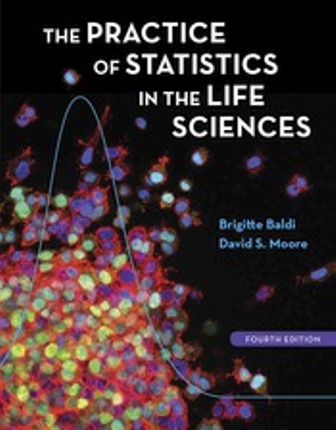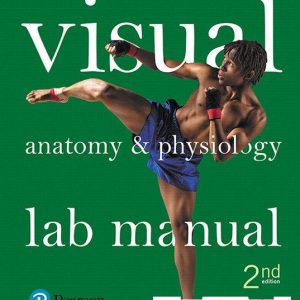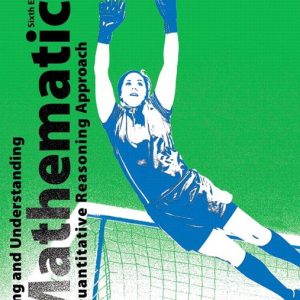This is completed downloadable of Test Bank for The Practice of Statistics in the Life Sciences, 4th Edition, Brigitte Baldi

Product Details:
- ISBN-10 : 1319013376
- ISBN-13 : 978-1319013370
- Author: Brigitte Baldi
See statisics through the eyes of a biologist as Practice of Statistics in the Life Sciences utilizes examples and exercises curated from across the life sciences in order to connect you to the material.
Table of Content:
- Part I: Collecting and Exploring Data
- Chapter 1 Picturing Distributions with Graphs
- Individuals and variables
- Identifying categorical and quantitative variables
- Categorical variables: pie charts and bar graphs
- Quantitative variables: histograms
- Interpreting histograms
- Quantitative variables: dotplots
- Time plots
- Discussion: (Mis)adventures in data entry
- Chapter 1 Summary
- This Chapter in Context
- Check Your Skills
- Chapter 1 Exercises
- Chapter 2 Describing Quantitative Distributions with Numbers
- Measures of center: median, mean
- Measures of spread: percentiles, standard deviation
- Graphical displays of numerical summaries
- Spotting suspected outliers
- Discussion: Dealing with outliers
- Organizing a statistical problem
- Chapter 2 Summary
- This Chapter in Context
- Check Your Skills
- Chapter 2 Exercises
- Chapter 3 Scatterplots and Correlation
- Explanatory and response variables
- Relationship between two quantitative variables: scatterplots
- Adding categorical variables to scatterplots
- Measuring linear association: correlation
- Chapter 3 Summary
- This Chapter in Context
- Check Your Skills
- Chapter 3 Exercises
- Chapter 4 Regression
- The least-squares regression line
- Facts about least-squares regression
- Outliers and influential observations
- Working with logarithm transformations
- Cautions about correlation and regression
- Association does not imply causation
- Chapter 4 Summary
- This Chapter in Context
- Check Your Skills
- Chapter 4 Exercises
- Chapter 5 Two-Way Tables
- Marginal distributions
- Conditional distributions
- Simpson’s paradox
- Chapter 5 Summary
- This Chapter in Context
- Check Your Skills
- Chapter 5 Exercises
- Chapter 6 Samples and Observational Studies
- Observation versus experiment
- Sampling
- Sampling designs
- Sample surveys
- Cohorts and case-control studies
- Chapter 6 Summary
- This Chapter in Context
- Check Your Skills
- Chapter 6 Exercises
- Chapter 7 Designing Experiments
- Designing experiments
- Randomized comparative experiments
- Common experimental designs
- Cautions about experimentation
- Ethics in experimentation
- Discussion: The Tuskegee syphilis study
- Chapter 7 Summary
- This Chapter in Context
- Check Your Skills
- Chapter 7 Exercises
- Chapter 8 Collecting and Exploring Data: Part I Review
- Part I summary
- Comprehensive review exercises
- Large data set exercises
- Online data sources
- EESEE case studies
- Part II: From Chance to Inference
- Chapter 9 Essential Probability Rules
- The idea of probability
- Probability models
- Probability rules
- Discrete versus continuous probability models
- Random variables
- Risk and odds
- Chapter 9 Summary
- This Chapter in Context
- Check Your Skills
- Chapter 9 Exercises
- Chapter 10 Independence and Conditional Probabilities
- Relationships among several events
- Conditional probability
- General probability rules
- Tree diagrams
- Bayes’s theorem
- Discussion: Making sense of conditional probabilities in diagnostic tests
- Chapter 10 Summary
- This Chapter in Context
- Check Your Skills
- Chapter 10 Exercises
- Chapter 11 The Normal Distributions
- Normal distributions
- The 68–95–99.7 rule
- The standard Normal distribution
- Finding Normal probabilities
- Finding percentiles
- Using the standard Normal table
- Normal quantile plots
- Chapter 11 Summary
- This Chapter in Context
- Check Your Skills
- Chapter 11 Exercises
- Chapter 12 Discrete Probability Distributions
- The binomial setting and binomial distributions
- Binomial probabilities
- Binomial mean and standard deviation
- The Normal approximation to binomial distributions
- The Poisson distributions
- Poisson probabilities
- Chapter 12 Summary
- This Chapter in Context
- Check Your Skills
- Chapter 12 Exercises
- Chapter 13 Sampling Distributions
- Parameters and statistics
- Statistical estimation and sampling distributions
- The sampling distribution of x̄
- The central limit theorem
- The sampling distribution of p̂
- The law of large numbers
- Chapter 13 Summary
- This Chapter in Context
- Check Your Skills
- Chapter 13 Exercises
- Chapter 14 Introduction to Inference
- Statistical estimation
- Margin of error and confidence level
- Confidence intervals for the mean μ
- Hypothesis testing
- P-value and statistical significance
- Tests for a population mean
- Tests from confidence intervals
- Chapter 14 Summary
- This Chapter in Context
- Check Your Skills
- Chapter 14 Exercises
- Chapter 15 Inference in Practice
- Conditions for inference in practice
- How confidence intervals behave
- How hypothesis tests behave
- Discussion: The scientific approach
- Planning studies: selecting an appropriate sample size
- Chapter 15 Summary
- This Chapter in Context
- Check Your Skills
- Chapter 15 Exercises
- Chapter 16 From Chance to Inference: Part II Review
- Part II summary
- Comprehensive review exercises
- Advanced topics (optional material)
- Online data sources
- EESEE case studies
- Part III: Statistical Inference
- Chapter 17 Inference about a Population Mean
- Conditions for inference
- The t distributions
- The one-sample t confidence interval
- The one-sample t test
- Matched pairs t procedures
- Robustness of t procedures
- Chapter 17 Summary
- This Chapter in Context
- Check Your Skills
- Chapter 17 Exercises
- Chapter 18 Comparing Two Means
- Comparing two population means
- Two-sample t procedures
- Robustness again
- Avoid the pooled two-sample t procedures
- Avoid inference about standard deviations
- Chapter 18 Summary
- This Chapter in Context
- Check Your Skills
- Chapter 18 Exercises
- Chapter 19 Inference about a Population Proportion
- The sample proportion p̂
- Large-sample confidence intervals for a proportion
- Accurate confidence intervals for a proportion
- Choosing the sample size
- Hypothesis tests for a proportion
- Chapter 19 Summary
- This Chapter in Context
- Check Your Skills
- Chapter 19 Exercises
- Chapter 20 Comparing Two Proportions
- Two-sample problems: proportions
- The sampling distribution of a difference between proportions
- Large-sample confidence intervals for comparing proportions
- Accurate confidence intervals for comparing proportions
- Hypothesis tests for comparing proportions
- Relative risk and odds ratio
- Discussion: Assessing and understanding health risks
- Chapter 20 Summary
- This Chapter in Context
- Check Your Skills
- Chapter 20 Exercises
- Chapter 21 The Chi-Square Test for Goodness of Fit
- Hypotheses for goodness of fit
- Expected counts and chi-square statistic
- The chi-square test for goodness of fit
- Interpreting significant chi-square results
- Conditions for the chi-square test
- Chapter 21 Summary
- This Chapter in Context
- Check Your Skills
- Chapter 21 Exercises
- Chapter 22 The Chi-Square Test for Two-Way Tables
- Two-way tables
- Hypotheses for two-way tables of counts
- Expected counts and chi-square statistic
- The chi-square test
- Conditions for the chi-square test
- The chi-square test and the two-sample z test
- Chapter 22 Summary
- This Chapter in Context
- Check Your Skills
- Chapter 22 Exercises
- Chapter 23 Inference for Regression
- The regression parameters
- Testing the hypothesis of no linear relationship
- Testing lack of correlation
- Confidence intervals for the regression slope
- Inference about prediction
- Checking the conditions for inference
- Chapter 23 Summary
- This Chapter in Context
- Check Your Skills
- Chapter 23 Exercises
- Chapter 24 One-Way Analysis of Variance: Comparing Several Means
- Comparing several means
- The F statistic
- The analysis of variance F test
- Conditions for ANOVA
- Details of ANOVA calculations
- Chapter 24 Summary
- This Chapter in Context
- Check Your Skills
- Chapter 24 Exercises
- Chapter 25 Statistical Inference: Part III Review
- Essential concepts from Parts I and II
- Part III summary
- Comprehensive review exercises: inference selection
- Comprehensive review exercises: analysis and conclusion
- Large data set exercises
- Online data sources
- EESEE case studies
- Part IV Optional Companion Chapters (available on the PSLS 4e Companion Website)
- Chapter 26 More about Analysis of Variance: Follow-up Tests and Two-Way ANOVA
- Beyond one-way ANOVA
- Follow-up analysis: Tukey pairwise multiple comparisons
- Follow-up analysis: contrasts
- Two-way ANOVA: conditions, main effects, and interaction
- Inference for two-way ANOVA
- Some details of two-way ANOVA
- Chapter 26 Summary
- Statistics in Summary
- This Chapter in Context
- Check Your Skills
- Chapter 26 Exercises
- Chapter 27 Nonparametric Tests
- Comparing two samples: the Wilcoxon rank sum test
- Matched pairs: the Wilcoxon signed rank test
- Comparing several samples: the Kruskal-Wallis test
- Chapter 27 Summary
- Statistics in Summary
- This Chapter in Context
- Check Your Skills
- Chapter 27 Exercises
- Chapter 28 Multiple and Logistic Regression
- Parallel regression lines
- Estimating parameters
- Using technology
- Conditions for inference
- Inference for multiple regression
- Interaction
- A case study for multiple regression
- Logistic regression
- Inference for logistic regression
- Chapter 28 Summary
- Statistics in Summary
- This Chapter in Context
- Check Your Skills
- Chapter 28 Exercises
- Back Matter
- Notes and Data Sources
- Notes
- Tables
- TABLE A: Random Digits
- TABLE B: Standard Normal Probabilities
- TABLE C: t Distribution Critical Values
- TABLE D: Chi-square Distribution Critical Values
- TABLE E: Critical Values of the Correlation r
- TABLE F: F Distribution Critical Values
- TABLE G: Critical values m* for Tukey pairwise multiple comparisons with 95% confidence level, k comparisons, and N – k degrees of freedom (df)
- Answers to Selected Exercises
- Some Studies Recurring Across Chapters
- Index
- A
- B
- C
- D
- E
- F
- G
- H
- I
- L
- M
- N
- O
- P
- Q
- R
- S
- T
- U
- V
- W
- X
- Z
- Symbols
- Back Cover





